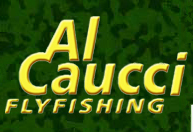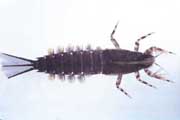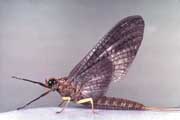
![]()
Trips
Montana
Missouri
SW
Montana
Clark Fork & Bitterroot
Bahamas
Andros Island
Upper Delaware
Other Destinations
Alaska
New Zealand
Argentina
Chile
![]()
News
![]()
River Updates
Hatch
Chart
![]()
Campground
![]()
Tips
Articles
ACFF
Photo Gallery
![]()
Al Caucci's Biography
Testimonials
![]()
Contact Us
Home
![]()
Your fishing logs at Ecolure
![]()
Friends of the
Upper
Delaware
![]()
1250 Winterdale Road
Starlight, PA, 18461
Phone : 1 ( 570 ) 635 - 5897
email : alcaucci@hancock.net

|
|||||||
|
The Exciting Late-Season Isonychia Hatches By Al Caucci A hatch of insects on a rich trout stream is usually a numbers game. A large concentration of bugs of a specific species will almost always cause ravenous surface feeding from trout-even those wild lunker browns which prefer to cruise the shallows for prey after dark. Sporadic hatching activity, on the other hand, can be very disappointing for the dry fly enthusiast. "Not enough bugs, ain't worth the effort," they seem to say, or at least imply by their lack of interest. Not so with the Isonychia mayflies. I can't count the number of times I've stood hip deep in a favorite run or pool on the Upper Delaware and watched in amazement as good-sized, wild trout take these duns like they were candy, even during the sparsest of hatches, and in broad daylight too! I've concluded that this behavior is caused by the fact that these flies hatch throughout most of the season, and the trout become accustomed to their emergence over a period of three to four months. They're also quite large-sizes 10 to 12 hook-but I like a size 14 in 4X long for better floatability. On my home waters on the West Branch of the Delaware, the hatch starts in late May and goes through the end of October. The main stem of the Delaware, (especially the upper 10 miles that benefit from the cold summer flows out of the West Branch) is good from late May through June, but is best from mid July to the end of October. The lower East Branch of the Delaware and the Beaverkill warm up in mid June through early September, but they come on strong in late September. The East Branch continues through the whole month of October, with surprisingly heavy hatches that can cause very selective feeding. Adirondack rivers, like the West Branch of the AuSable, have a nice hatch for two weeks in September. Pocono streams, like the Brodhead, have good hatching in September also. Midwestern rivers, such as the Ausable, have heavy hatches in June and July, but continue sporadic hatching into September. The Isonychia nymphs are large, swift swimmers. Like many of the stoneflys of the Plecoptera order, these nymphs are predacious and will feed on minute Diptera and caddis larvae, as well as tiny mayfly nymphs. These swift, highly-streamlined nymphs are among the easiest to recognize. They are usually large (12mm-16mm), brownish-black with a whitish mid-dorsal stripe, and have explosive starts when swimming.
The gills are similar, being ovoid or plate-like, and are located on the first seven abdominal segments. Each pair of plate-like gills has a second, filamentous portion that is partially obscured beneath it. In addition, these nymphs have gill-tufts present under the thorax at the base of the forecoxae (similar to the gills of a stonefly). The forelegs have long, basket-like, spiney hairs on the femur and tibia, which are most noticeable on the tibia. The nymphs have three heavily-fringed tails-fringed on both sides of the middle tail, as well as the inner sides of the two outer tails.
The duns and spinners have reddish-brown bodies. The wings of the dun are dark gray with milky-soft areas in the lower-center portion of the fore and hind wings, but after molting they become sparkling-clear (hyaline). The large eyes of the male are contiguous at the top of the head in the imago state, but not quite in the dun stage. Both male and female eyes have an oblique strip which is noticeable after the specimen is exposed to light. The middle tail is lost in the transition from nymph to dun, and the remaining tails are pale cream or white, as are the middle and rear pairs of legs. The dark forelegs are similar in color to the body. It pays to carry dun, emerger, spinner and nymph patterns in your fly box when fishing the Isonychia hatch. Comparaduns and emergers are the proven patterns on the Upper Delaware, while many anglers in the Midwest also use extended-body patterns. Imitations should cover the range from size 10 to size 14. The Zug Bug nymph is a proven pattern for subsurface action throughout the East and Midwest. My staff of guides, as well as most veteran fly fishers on the Upper Delaware, agree that the late summer and fall Isonychia hatch is truly unique. It is one of the very few events where you can actually entice trout to rise to a dry fly even when there are no naturals on the water. This is unprecedented on rich rivers like the Delaware and other prolific tail-waters, where trout just don't rise to the surface unless there is a very good hatch of naturals underway.
|
|||||||

